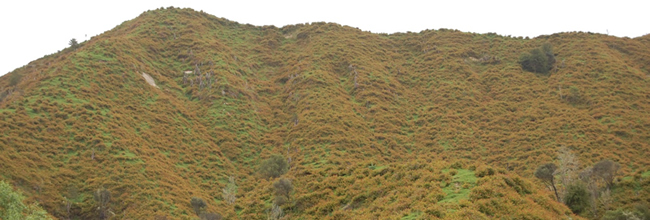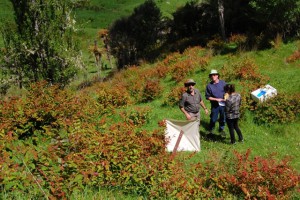Application to release biocontrol agents for tutsan

The decision can be found on EPA's website.
Background
This application will be submitted on behalf of the Tutsan Action Group, a community-based consortium comprising over 100 farmers, regional council and Department of Conservation conservancies, and supported by the MPI Sustainable Farming Fund, Meat and Wool New Zealand and Landcare Research. Landcare Research is also the science provider for this development.
Landcare Research has contracted Richard Hill & Associates to prepare the application and to manage the application process on behalf of Horizons Regional Council, including pre-application consultation with EPA and with Māori and other stakeholders.
Rationale
Tutsan (Hypericum androsaemum L., Hypericaceae) is an evergreen or semi-evergreen shrub that grows to about 1.5 m tall. Introduced as a garden ornamental, it was first recorded as naturalised in 1892. It was noted as a weed of local significance in 1955, but since then has become a serious weed in the North Island. It has taken much sheep-grazed hill country out of production, especially in the Ruapehu district.
It is also recognised as a weed of native plant communities such as shrublands, tussock grasslands and bare land. Tutsan can have a major effect on native species, or on the composition or density of dominant species in those communities. Originally from Europe east to the Caucasus. Tutsan is established in many countries and is also regarded as a significant weed in Australia.
For more information on Tutsan see this Tutsan Action Group booklet
There is active research into three potential control agents, and an application to introduce two of these is being prepared.
- The larvae of the moth Lathronympha strigana (L.) feed on leaf tips, tying tips together, and can be found inside the stems of plants, causing leaf fall and dieback. The primary damage done to the plant is seed destruction where larvae can consume at least one entire seed pod during development.
- The larvae and adults of the beetle Chrysolina abchasica (Weise) feed on the leaves, causing defoliation.
More information on the biological control agents of tutsan
Identification and assessment of risks, costs and benefits
The potential risks, costs and benefits of the proposed introduction to New Zealand of two insects and the possible reduction in the abundance and vigour of tutsan have been identified by literature review and by consultation with stakeholders. The significant effects identified (bolded) will be addressed in details in the application:
- Risks, costs and benefits of tutsan control
Tutsan is an unwanted organism and it is forbidden to sell, propagate or distribute this plant. Tutsan has no significant economic or environmental value.
The potential benefits of biological control would be the reduction of the economic costs associated with the weed.
The possible adverse effects of introducing the control agents will be addressed fully in the application:
- the risk of direct damage to native plants
- indirect effects on flora and fauna as a result of disruption of ecological relationships
- the removal of tutsan as a food source for native birds
- the risk of direct damage to valued garden ornamentals
There are four native species in the genus Hypericum. The application will present evidence to show that these species will not be at risk. The next most closely related species is an aquatic plant that will not be at risk. No other native species are related to the target weed.
Because the control agents are largely host specific, population densities capable of interacting significantly with other plants or animals will only be found in close proximity to tutsan. As a result, any disturbance of ecological relationships is expected in New Zealand to be localised. The presence of tutsan itself massively modifies natural interactions between species, and any reduction in the weed will help reverse those impacts. Tutsan is unlikely to be a major part of the diet of native birds.
Pre-application consultation with Iwi
The members of the EPA's national network Te Herenga will be contacted in August 2015, and invited to enter dialogue on the National Biocontrol Collective's plans to apply to EPA to introduce biological control agents to attack tutsan.
The message to Te Herenga will describe how the applicant intends to assess the risks, costs and benefits associated with the proposed introductions. Members will be invited to identify any issues that they would like to be addressed in the applications. The outcome of previous consultations will be presented.
EPA recently convened a reference group from Te Herenga to meet and discuss the issues surrounding applications to introduce biological control agents. The reference group's report to EPA will be found here.
Members of Te Herenga will be informed by EPA when the application is open for public submission, and will be able to comment on how the applicant has addressed issues raised during consultation.
Additional consultation will be undertaken with iwi in the applicant’s region.
The responses by Te Herenga members and other correspondents specifically related to the proposed introduction of the two control agents will be summarised here:
Pre-application consultation with other organisations
Other organisations to be consulted include:
- Nursery and Garden Industry New Zealand
- Regional and District Councils
- Royal Forest and Bird Protection Society of New Zealand
- Department of Conservation
- QEII National Trust
- NZ Landcare Trust
- Others
Key documents
Safety issues are paramount in the minds of biocontrol of weeds researchers. Researchers rigorously test all proposed agents to assess the risk of damage to non-target plants. A set of procedures helps researchers choose a suitable shortlist of test plants, and this methodology is now well-accepted internationally (Wapshere, 1974). The technique is under constant review to update best practice (e.g. Sheppard et al., 2005; Briese, 2005).
The results of host range testing of the two control agents will be fully discussed in the application. Tests were completed in the containment facility located at Landcare Research, Lincoln. A report has been compiled by Hugh Gourlay, Landcare Research that discusses host plant selection, and the test results. This report can be found here:
This unpublished report will be peer reviewed and that review will be provided to EPA.
A report on the prospects for biological control of tutsan in New Zealand was prepared by Landcare Research for the Tutsan Action Group.
A survey of the invertebrate fauna and fungi associated with tutsan in New Zealand was carried out from November 2011 to March 2012 by Landcare Research for the Tutsan Action Group.
The feasibility of biological control of tutsan in New Zealand was investigated for the Tutsan Action Group.
Cited references
Briese D (2005). Translating host-specificity test results into the real world: The need to harmonize the yin and yang of current testing procedures. Biological Control 35: 208–214.
Burton G. (2013). The economic cost of tutsan (Hypericum androsaemum L.) to New Zealand. Contract report prepared for the Tutsan Action Group. Geoff Burton Farm Business Management, 13 p.
Groenteman R (2009). Prospects for the biological control of tutsan (Hypericum androsaemum L.). Landcare Research Contract Report LC0809/146, for the Tutsan Action Group. 25 p.
Rendell E, Gourlay H (2012). Survey of invertebrate and pathogenic fauna of tutsan (Hypericum androsaemum) and DNA analysis of New Zealand plant populations. Landcare Research Contract Report: LC 1083, 34 p.
Sheppard AW, Heard TA, van Klinken RD (2005). Scientific advances in the analysis of direct risks of weed biological control agents to non-target plants. Biological Control 35: 215–226.
Wapshere AJ (1974). A strategy for evaluating the safety or organisms for biological weed control. Annals of Applied Biology 77: 201–211.
Downloadable content & links
- pdf Tutsan Action Group booklet pdf File, 3.4 MB
- pdf Summary of responses to public consultation pdf File, 60 KB
- pdf Summary of responses to consultation with Te Herenga pdf File, 650 KB
- pdf Survey of invertebrate and pathogenic fauna of tutsan (Hypericum androsaemum) and DNA analysis of New Zealand plant populations pdf File, 2.6 MB
- pdf Evaluation of the host range of Lathronympha strigana (L.) (Tortricidae), and Chrysolina abchasica (Weise) (Chrysomelidae), potential biological control agents for tutsan, Hypericum androsaemum L. pdf File, 270 KB
- pdf Prospects for the biological control of tutsan (Hypericum androsaemum L.). pdf File, 284 KB
- pdf The Economic Cost of Tutsan (Hypericum androsaemum L.) to New Zealand pdf File, 150 KB




